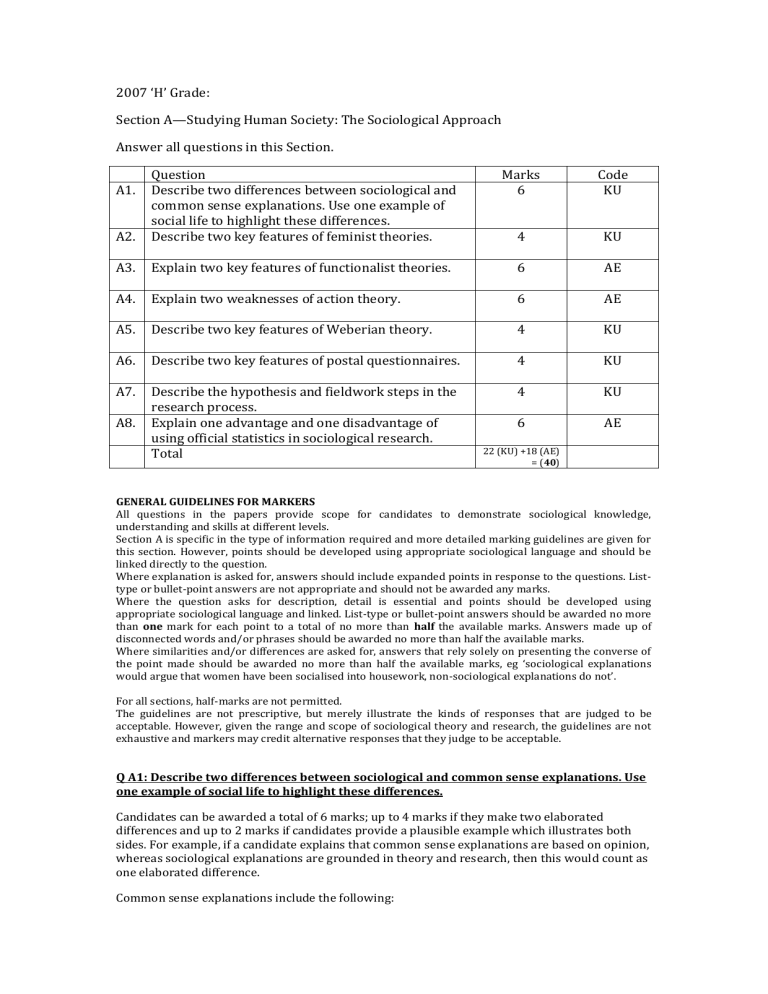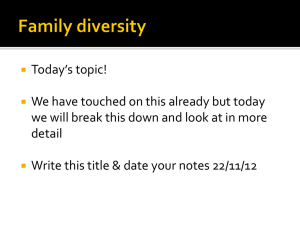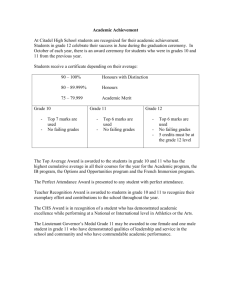2007 `H` Grade: Section A—Studying Human Society: The

2007 ‘H’ Grade:
Section A—Studying Human Society: The Sociological Approach
Answer all questions in this Section.
Question
A1. Describe two differences between sociological and common sense explanations. Use one example of social life to highlight these differences.
A2. Describe two key features of feminist theories.
Marks
6
Code
KU
A3. Explain two key features of functionalist theories.
A4. Explain two weaknesses of action theory.
A5. Describe two key features of Weberian theory.
A6. Describe two key features of postal questionnaires.
A7. Describe the hypothesis and fieldwork steps in the research process.
A8. Explain one advantage and one disadvantage of using official statistics in sociological research.
Total
4
6
6
4
4
4
6
22 (KU) +18 (AE)
= (40)
KU
AE
AE
KU
KU
KU
AE
GENERAL GUIDELINES FOR MARKERS
All questions in the papers provide scope for candidates to demonstrate sociological knowledge, understanding and skills at different levels.
Section A is specific in the type of information required and more detailed marking guidelines are given for this section. However, points should be developed using appropriate sociological language and should be linked directly to the question.
Where explanation is asked for, answers should include expanded points in response to the questions. Listtype or bullet-point answers are not appropriate and should not be awarded any marks.
Where the question asks for description, detail is essential and points should be developed using appropriate sociological language and linked. List-type or bullet-point answers should be awarded no more than one mark for each point to a total of no more than half the available marks. Answers made up of disconnected words and/or phrases should be awarded no more than half the available marks.
Where similarities and/or differences are asked for, answers that rely solely on presenting the converse of the point made should be awarded no more than half the available marks, eg ‘sociological explanations would argue that women have been socialised into housework, non-sociological explanations do not’.
For all sections, half-marks are not permitted.
The guidelines are not prescriptive, but merely illustrate the kinds of responses that are judged to be acceptable. However, given the range and scope of sociological theory and research, the guidelines are not exhaustive and markers may credit alternative responses that they judge to be acceptable.
Q A1: Describe two differences between sociological and common sense explanations. Use one example of social life to highlight these differences.
Candidates can be awarded a total of 6 marks; up to 4 marks if they make two elaborated differences and up to 2 marks if candidates provide a plausible example which illustrates both sides. For example, if a candidate explains that common sense explanations are based on opinion, whereas sociological explanations are grounded in theory and research, then this would count as one elaborated difference.
Common sense explanations include the following:
• based on opinion
• may be individualistic or naturalistic
• lack objectivity
• carries notions of being factual.
Sociological explanations include the following aspects:
• based on particular theories which have been tested through research
• attempts to be objective
• attempts to be value free or acknowledges role of values in formulating theories
• challenges taken for granted assumptions.
Examples may come from any area but should demonstrate an example of a sociological and a common sense explanation.
To be awarded 2 marks candidates must clearly express their point as a difference between common sense and sociological explanations.
Examples could include:
• people marry because they love each other vs. people marry because it is a social expectation
• people are unemployed because they are lazy and don’t want to work vs. the structure of employment has changed
• people are poor because they do not budget properly vs. people are poor because of low wages and low benefits
• people commit suicide because they are unhappy vs. rates of suicide are socially distributed and can be attributed to social factors such as unemployment, religion, urbanisation, etc.
Q A2: Describe two key features of Feminist theories.
Award up to 4 marks for this answer; up to 2 marks for each feature described. Description is asked for in the question and therefore the answer requires description and detail. Award 1 mark for key features that are stated rather than described and for answers that lack sociological language/terms.
Answers may include description of the following points:
• Types of feminist perspectives – Marxist, radical, liberal and black
• Marxist:
• capitalism and male domination
• issues of production and reproduction
• Radical:
• patriarchy irrespective of economic system
• issues relating to any type of male power
• Liberal:
• Black:
• inequality between men and women arises because of unfair laws
• Compounded discrimination − racial and gender
• Redress male-dominated sociological analysis.
• Analyse society from a female perspective.
Q A3: Explain two key features of functionalist theories.
Award up to 6 marks for this answer; up to 3 marks for each feature explained. Explanation is asked for in the question and therefore the answer requires more than simple description. Award
1 mark for key features that are described rather than explained and for answers that lack sociological language/terms.
Answers may include explanation of the following points:
• Functionalism is an example of a consensus theory and stresses harmony, integration and stability.
• Functionalism is a structural theory which takes a macro-approach to the study of society; functionalist theorists tend to see the structure of society as being made up of integrated social institutions.
• Functionalist theorists stress value consensus.
Q A4: Explain two weaknesses of action theory.
Candidates can be awarded up to 6 marks for this question. The question requires candidates to explain two weaknesses. Analytical or evaluative comments should be awarded higher marks.
For example, when candidate phrases answers in a way that draws contrasts.
Weaknesses may include:
• Tends to locate explanations at the level of the individual/group
• Tends to see human interaction in a vacuum (what about history and social structure?)
• May look at ‘meaning’ but does not always provide origins of that meaning
• Leaves itself open to accusations of ‘subjectivity’ and ‘common sense’
If candidate simply identifies weaknesses then award 1 mark for each one identified. If candidate makes a clear distinction between each perspective award up to 3 marks for each identified.
Q A5: Describe two key features of Weberian theory.
Award up to 4 marks for this answer; up to 2 marks for each feature described. Description is asked for in the question and therefore the answer requires description and detail. Award 1 mark for key features that are stated rather than described and for answers that lack sociological language/terms.
Answers may include description of the following points:
• Class, party and status
• Envisaged the development of capitalism – more complex structures and the rise of bureaucracy
• Bridge between structure and action theory
Q A6: Describe two key features of postal questionnaires.
Candidate can be awarded up to 4 marks for this question. Allow up to 2 marks per advantage and per disadvantage. Only one mark should be given for each if the response is limited – for example, one-word answers and/or simple statements that lack sociological language/terms.
Credit candidates who explain features as advantages.
Postal Questionnaires:
Answers may include description of the following points:
• It is a primary source of data
• It will produce quantitative data
• Usually involves a list of pre-set questions that are posted to the respondent, they then complete it and then return it to the researchers
• Closed questions are normally used.
Q A7: Describe the hypothesis and fieldwork steps in the research process.
Candidate can be awarded up to 4 marks for this question. 2 marks per stage for explanation but only up to a maximum of 1 mark for each step if the responses are limited.
Answers may include description of the following points:
Hypothesis:
• An idea to be tested
• Can be expressed as a statement
• Can be proved true or false
Fieldwork:
• Conducting the research
• Researcher carries out research using appropriate methods, eg participant observation
• Researcher uses relevant sample
Q A8: Explain one advantage and one disadvantage of using official statistics in
sociological research.
Up to 6 marks can be awarded. Up to 3 marks may be awarded for one advantage and up to 3 marks for one disadvantage. If candidate gives one-word answers then no more than one mark should be awarded for each advantage or disadvantage. Markers should note some advantages/disadvantages may be expressed as features and vice versa – this is acceptable as long as the point is stated clearly by the candidate.
Answers may include explanation of the following points:
Key Features:
Official statistics gathered by official bodies, eg police, health trusts, etc.
Used to show trends
Used as a basis for planning, policy, etc.
Advantages:
Good for quantitative studies – how many crimes have been reported in any one year
Can save researcher lot of time
May show general trends for particular behaviour
Disadvantages:
May be biased because of the way data is collected
May be collected and/or presented for a specific reason, eg unemployment figures
May be difficult to do comparison on longitudinal studies because different criteria may be used when gathering statistics, eg class criteria
All statistics still require interpretation
Official statistics can describe but not explain






